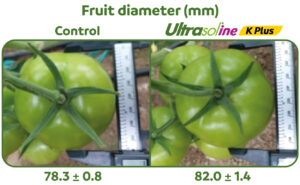Balanced plant nutrition, at the right time, is the key to optimising yield and quality in tomato production, whether grown in the soil or in greenhouse mediums. Maintaining the correct balances is a management practice that is easily attained.
Soil sampling for field grown crops, is an essential management tool to determine the correct ratios of nutrients to be applied. In greenhouse production, Combrink and Kempen in ‘Nutrient Solution Management’, suggest the following levels in mmolc /L (meq/L) for “drain to waste” hydroponic systems in South African conditions: NH4+ 1, K+ 7, Ca++ 8.5, Mg++ 3.5, NO3- 12.5, H2PO4- 1.5, SO4-- 6 and trace elements in mg/L: Fe 0.85, Mn 0.55, Zn 0.3, B 0.3, Cu 0.05 and Mo 0.05. This to be applied at an electrical conductivity of 2 mS/cm.
Yield components affected by poor nutritional balances will be fruit set, fruit growth, yield, ripening, colour, firmness, shelf life, russeting, total sugars, acidity, puffiness, blossom end rot, goldspeck, cracking, sunscald, disease, internal white tissue and corkiness.
In field grown and hydroponic crops, potassium and then nitrogen are the two elements most used by the tomato crop. For field grown crops and a target of 100 mt per hectare, recommendations of 250-300 kg N and 350-400 kg K per hectare are not uncommon. All elements are important but after N and K+, the positive cations Ca++ and Mg++ are also taken up in relatively high quantities.
In field grown and hydroponic crops, potassium and then nitrogen are the two elements most used by the tomato crop.
The question is, how does one optimize the uptake of the cations: K+, Ca++ and Mg++ into any crop? A plant grows best when electrochemically balanced and this can be facilitated by using a negative counter ion (anion) to work synergistical-ly with the positive cations. The best way to achieve this is by maximizing the amount of negatively charged NO3- (Nitrate anions) in conjunction with the positively charged cations.
Potassium nitrate (Ultrasol® K Plus) is one of the products used to maximize the nitrates to facilitate and optimize the uptake of potassium, calcium and magnesium into the to-mato crop. A good example of inadequate nitrate nutrition (therefore, by implication, an excess of Ammonium-N) is the incidence of ‘blossom end rot’ which is a ‘physiologically induced’ calcium deficiency caused by uptake competition between the NH4+ and the Ca++, even though Ca++ is given in adequate quantities. The same uptake competition is happening between the NH4+-N and the K+ and Mg++ cations.
The ratio of nitrate-N to ammonium-N near the tomato plant roots (rhizosphere) should ideally be greater than 75:25 respectively for field crops and greater than 90 :10 in hydroponically grown crops. Not only does this synergistically enhance the uptake of the cations by maintaining an electrochemical balance within the plant but also maintains an optimal pH in the rhizosphere.
The benefits of balanced nutrition, optimum rhizosphere pH and dry matter accumulation have implications for improvements in both yield and quality.
Excess ammonium nutrition (ammonium or urea-based fertilizer) should be avoided, as the NH4+ cation will not only interfere or compete with the other cation uptake, but can also lower the rhizosphere pH by 1.5 pH units. Since pH is a logarithmic scale, the pH reduction near the roots can be in the order of 10 to 100 x more acidic than it should be. Ad-ditionally, under warm root conditions, ammonium nutrition can cause ammonia toxicity in the roots, as the next step to organic compounds can be blocked in warm roots. The tomato plants will wilt and die as a result.
In all horticultural crops, dry matter accumulation is great-est, up to double in certain cases, when nitrate-N is the preferred nitrogen source. In many crops, nitrate is converted to organic compounds mostly, but not always, in the leaves and ammonium is converted to organic compounds almost exclu-sively in the roots. The conversion of ammonium-N to organic compounds in the roots is energy inefficient, requiring carbo-hydrate energy translocated from the leaves. The conversion of nitrate-N to organic compounds in the leaves is largely driven by light energy and is thus energy efficient, leaving more carbohydrates for dry matter accumulation by the crop.
The benefits of balanced nutrition, optimum rhizosphere pH and dry matter accumulation have implications for im-provements in both yield and quality. The grower’s return on investment (ROI – money in the pocket) will increase as a result thereof. Using Ultrasol® K Plus as the potassium source will improve the overall ROI.



*Reg No K520 Act 36/1947. Registration holder Sociedad Quimica y Minera (Africa)(Pty)Ltd.
**All claims in this article can be substantiated with referenc-es which can be made available on request.
Disclaimer: The information herein contained is given to the best of SQM’s knowledge and is believed to be accurate. The conditions of your use and application of the suggested recommendations are beyond our control. No warranty is made as to the accuracy of any data or statements contained herein. SQM specifically disclaims any responsibility or liability relating to the use of the recommendations and shall under no circumstances whatsoever, be liable for any spe-cial, incidental or consequential damages arising from such use.



